(聲明:以下內容都是在網路上整理並修改的,真正我原創的內容並不多,我主要只是搬運工)
原本想做英文翻譯到繁體中文的範例,結果連資料集我都還沒找到,所以目前只能先把翻到一半的文章貼上。
此文章為Transformer from scratch using pytorch根據我的理解的中文版本。
有錯的話請通知我
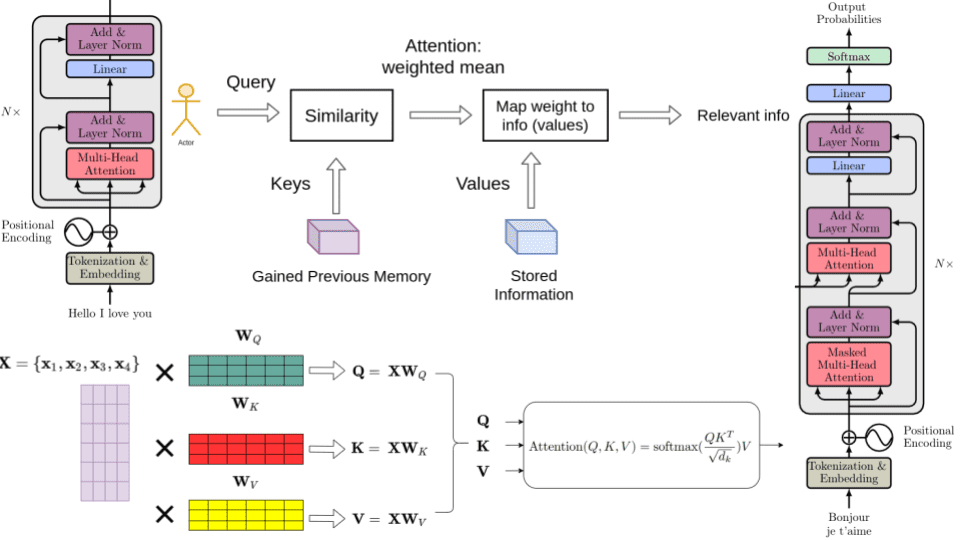
在本教程中,將會嘗試使用PyTorch從頭開始實現“Attention is All You Need”論文中的Transformers。基本上,Transformer採用了一種編碼器-解碼器架構,現在此架構在語言翻譯模型中很常見。
注意:在此,這邊不會深入解釋Transformers。對此,請參考Jay Alammar的博客。(英文苦手的話裏面blog也有中文翻譯的連結)他對Transformers的內部工作原理給予了深入的解釋。我們將僅專注於程式碼部分。
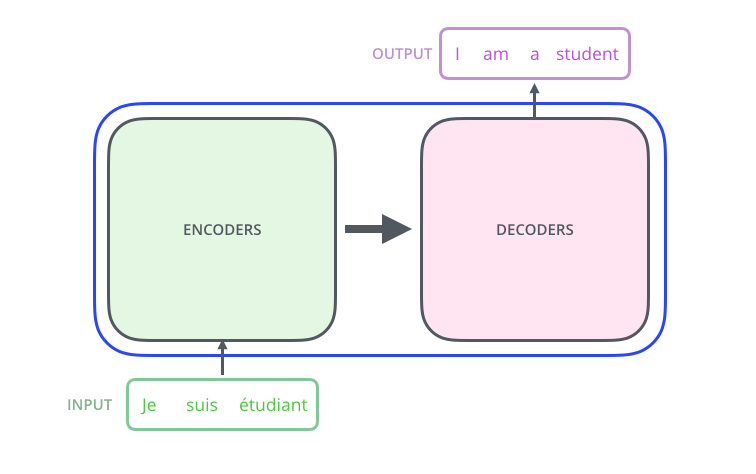
上面的圖像顯示了一個從法語到英語的語言翻譯模型。實際上,我們可以使用編碼器的堆疊(每個編碼器的輸出)和解碼器的堆疊,如下所示: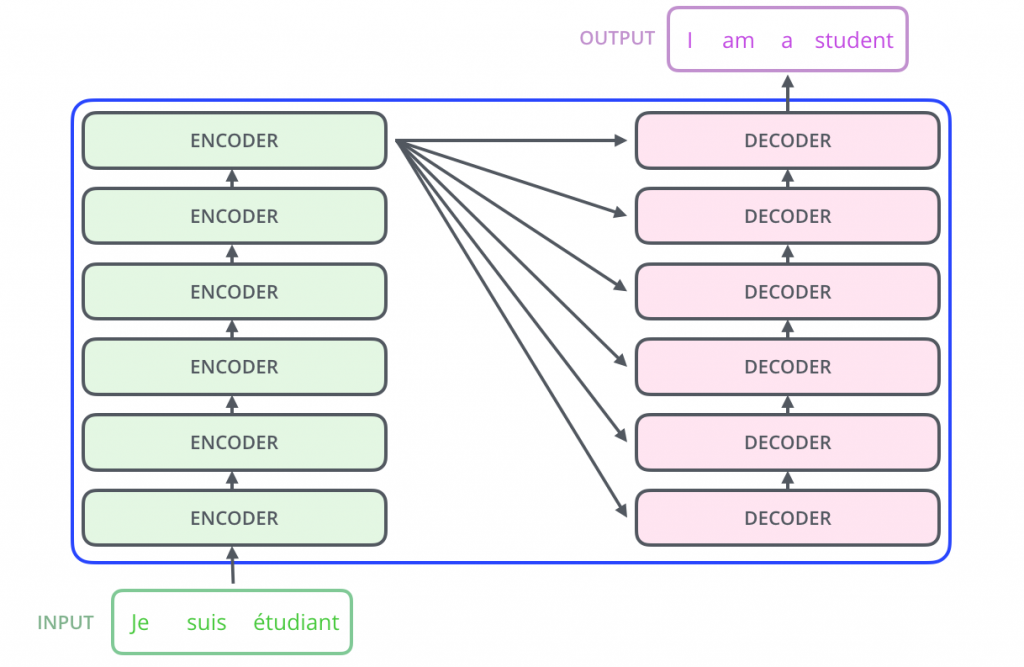
在進一步了解之前,這邊先看一下這邊實現注意力模型的完整圖像。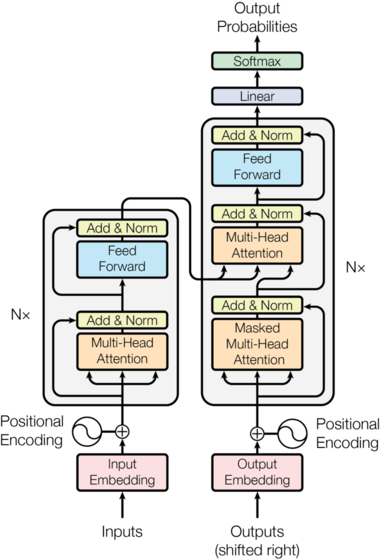
# importing required libraries
import torch.nn as nn
import torch
import torch.nn.functional as F
import math,copy,re
import warnings
import pandas as pd
import numpy as np
import seaborn as sns
import torchtext
import matplotlib.pyplot as plt
warnings.simplefilter("ignore")
print(torch.__version__)
對於語言翻譯,Transformer 有一個編碼器解碼器架構。在深入編碼器或解碼器之前,這邊先介紹下一些常見的組件。
##創建詞嵌入:
首先,我們需要將輸入序列中的每個詞轉換為一個嵌入向量。嵌入向量將為每個詞創建一個更語義化的表示。
假設每個嵌入向量的維度為512,假設我們的詞彙量大小為100,那麼我們的嵌入矩陣將是100x512的大小。這些矩陣將在訓練過程中被學習,並且在推論過程中,每個詞將被映射到相應的512維向量。假設我們有批量大小為32,並且序列長度為10(10個詞)。那麼輸出將是32x10x512。
class Embedding(nn.Module):
def __init__(self, vocab_size, embed_dim):
"""
Args:
vocab_size: size of vocabulary
embed_dim: dimension of embeddings
"""
super(Embedding, self).__init__()
self.embed = nn.Embedding(vocab_size, embed_dim)
def forward(self, x):
"""
Args:
x: input vector
Returns:
out: embedding vector
"""
out = self.embed(x)
return out
下一步是生成位置編碼。為了讓模型理解句子,它需要知道每個詞的兩件事:
在 "Attention is All You Need" 這篇論文中,作者使用了以下函數來創建位置編碼。在奇數時間步,使用餘弦函數,而在偶數時間步,使用正弦函數。
同學, 國中數學思密達

pos -> 指的是在句子中的順序
i -> 指的是嵌入向量的位置
位置嵌入向量將會生成一個類似於嵌入矩陣的矩陣向量。它將創建一個維度為序列長度 x 嵌入維度的矩陣。對於序列中的每個標記(單詞),我們將找到維度為 1 x 512 的嵌入向量,並將其與維度為 1 x 512 的相應位置向量相加,以獲得每個單詞/標記的 1 x 512 維輸出。
例如:如果我們的批次大小為 32,序列長度為 10,並且讓嵌入維度為 512。那麼我們將有維度為 32 x 10 x 512 的嵌入向量。同樣,我們將有維度為 32 x 10 x 512 的位置編碼向量。然後我們將兩者相加。

# 在 Pytorch 中註冊 Buffer ->
# 如果你的模型中有參數,這些參數應該在 state_dict 中被保存和恢復,,
# 但是不應該被optimizer訓練,那麼你應該將它們註冊為buffer。
class PositionalEmbedding(nn.Module):
def __init__(self,max_seq_len,embed_model_dim):
"""
Args:
seq_len: length of input sequence
embed_model_dim: demension of embedding
"""
super(PositionalEmbedding, self).__init__()
self.embed_dim = embed_model_dim
pe = torch.zeros(max_seq_len,self.embed_dim)
for pos in range(max_seq_len):
for i in range(0,self.embed_dim,2):
pe[pos, i] = math.sin(pos / (10000 ** ((2 * i)/self.embed_dim)))
pe[pos, i + 1] = math.cos(pos / (10000 ** ((2 * (i + 1))/self.embed_dim)))
pe = pe.unsqueeze(0)
self.register_buffer('pe', pe)
def forward(self, x):
"""
Args:
x: input vector
Returns:
x: output
"""
# make embeddings relatively larger
x = x * math.sqrt(self.embed_dim)
#add constant to embedding
seq_len = x.size(1)
x = x + torch.autograd.Variable(self.pe[:,:seq_len], requires_grad=False)
return x
這邊簡單介紹一下自我注意力和多頭注意力。
什麼是自我注意力?
假設我們有一個句子 “狗正在過馬路,因為它看到了廚房”。這裡的 “它” 指的是什麼?對人類來說,很容易理解 “它” 是指 “狗”。但對機器來說,並不容易。
當模型處理每個單詞時,自我注意力允許它查看輸入序列中的其他位置以獲取線索。它將根據每個單詞與其他單詞的依賴關係創建一個向量。
讓我們逐步說明自我注意力的計算過程。
計算自注意力(self-attention)的第一步是從編碼器的每個輸入向量(在這種情況下,是每個單詞的嵌入向量)創建三個向量。所以對於每個單詞,我們創建一個查詢向量(Query vector),一個鍵向量(Key vector),和一個值向量(Value vector)。每個向量的維度將為 1x64。 由於我們有多頭注意力,我們將有 8 個自注意力頭。我將以 8 個注意力頭為例來解釋代碼。
以下是我的理解,有錯請跟我說。
『
向量(Query vector):可以理解為一個字詞的多維特徵(可類比人的臉)
鍵向量(Key vector):可以理解為要抽取的特定方向
值向量(Value vector):抽取處理出來的矩陣特徵
8 個注意力頭:這邊大概是論文作者把人類一次只能記住7~10個長度的東西侷限當作參考。』
如何創建鍵、查詢和值?
我們將有一個鍵矩陣,查詢矩陣和值矩陣來生成鍵,查詢和值。這些矩陣在訓練過程中是學習得到的。
程式碼提示: 假設我們有批次大小為32,序列長度為10,嵌入維度為512。所以在嵌入和位置編碼後,我們的輸出將為32x10x512的維度。 我們將其調整為32x10x8x64的維度。(關於8,它是多頭注意力中的頭的數量。不用擔心,一旦你閱讀過程式碼,你就會知道它是什麼。)。
第二步是計算得分。也就是,我們將查詢矩陣與鍵矩陣相乘。[Q x K・t]
假設我們的鍵、查詢和值維度為32x10x8x64。在進一步處理之前,我們將對它們進行轉置以便於乘法運算(32x8x10x64)。現在將查詢矩陣與鍵矩陣的轉置相乘。即 (32x8x10x64) x (32x8x64x10) -> (32x8x10x10)。
現在將輸出矩陣除以鍵矩陣維度的平方根,然後對其應用Softmax。
程式碼提示:我們將32x8x10x10向量除以8,即64(鍵矩陣的維度)的平方根
然後將其與值矩陣相乘。
程式碼提示: 步驟3之後,我們的輸出將為32x8x10x10維度。現在將其與值矩陣(32x8x10x64)相乘,得到輸出維度為(32x8x10x64)。這裡8是注意力頭的數量,10是序列長度。因此,對於每個單詞,我們都有64維向量。
一旦我們有了這個,我們將通過一個線性層傳遞它。這形成了多頭注意力的輸出。
程式碼提示: (32x8x10x64)向量被轉置為(32x10x8x64),然後重塑為(32x10x512)。然後它通過一個線性層得到(32x10x512)的輸出。
現在你對多頭注意力的工作原理有了一個概念。一旦你通過它的實現部分,你會更清楚。
class MultiHeadAttention(nn.Module):
def __init__(self, embed_dim=512, n_heads=8):
"""
Args:
embed_dim: dimension of embeding vector output
n_heads: number of self attention heads
"""
super(MultiHeadAttention, self).__init__()
self.embed_dim = embed_dim #512 dim
self.n_heads = n_heads #8
self.single_head_dim = int(self.embed_dim / self.n_heads) #512/8 = 64 . each key,query, value will be of 64d
#key,query and value matrixes #64 x 64
self.query_matrix = nn.Linear(self.single_head_dim , self.single_head_dim ,bias=False) # single key matrix for all 8 keys #512x512
self.key_matrix = nn.Linear(self.single_head_dim , self.single_head_dim, bias=False)
self.value_matrix = nn.Linear(self.single_head_dim ,self.single_head_dim , bias=False)
self.out = nn.Linear(self.n_heads*self.single_head_dim ,self.embed_dim)
def forward(self,key,query,value,mask=None): #batch_size x sequence_length x embedding_dim # 32 x 10 x 512
"""
Args:
key : key vector
query : query vector
value : value vector
mask: mask for decoder
Returns:
output vector from multihead attention
"""
batch_size = key.size(0)
seq_length = key.size(1)
# query dimension can change in decoder during inference.
# so we cant take general seq_length
seq_length_query = query.size(1)
# 32x10x512
key = key.view(batch_size, seq_length, self.n_heads, self.single_head_dim) #batch_size x sequence_length x n_heads x single_head_dim = (32x10x8x64)
query = query.view(batch_size, seq_length_query, self.n_heads, self.single_head_dim) #(32x10x8x64)
value = value.view(batch_size, seq_length, self.n_heads, self.single_head_dim) #(32x10x8x64)
k = self.key_matrix(key) # (32x10x8x64)
q = self.query_matrix(query)
v = self.value_matrix(value)
q = q.transpose(1,2) # (batch_size, n_heads, seq_len, single_head_dim) # (32 x 8 x 10 x 64)
k = k.transpose(1,2) # (batch_size, n_heads, seq_len, single_head_dim)
v = v.transpose(1,2) # (batch_size, n_heads, seq_len, single_head_dim)
# computes attention
# adjust key for matrix multiplication
k_adjusted = k.transpose(-1,-2) #(batch_size, n_heads, single_head_dim, seq_ken) #(32 x 8 x 64 x 10)
product = torch.matmul(q, k_adjusted) #(32 x 8 x 10 x 64) x (32 x 8 x 64 x 10) = #(32x8x10x10)
# fill those positions of product matrix as (-1e20) where mask positions are 0
if mask is not None:
product = product.masked_fill(mask == 0, float("-1e20"))
#divising by square root of key dimension
product = product / math.sqrt(self.single_head_dim) # / sqrt(64)
#applying softmax
scores = F.softmax(product, dim=-1)
#mutiply with value matrix
scores = torch.matmul(scores, v) ##(32x8x 10x 10) x (32 x 8 x 10 x 64) = (32 x 8 x 10 x 64)
#concatenated output
concat = scores.transpose(1,2).contiguous().view(batch_size, seq_length_query, self.single_head_dim*self.n_heads) # (32x8x10x64) -> (32x10x8x64) -> (32,10,512)
output = self.out(concat) #(32,10,512) -> (32,10,512)
return output
好的,現在你可能會突然有個問題。這個遮罩(Mask)是用來做什麼的?
別擔心,當介紹解碼器時,就會有相關的內容。
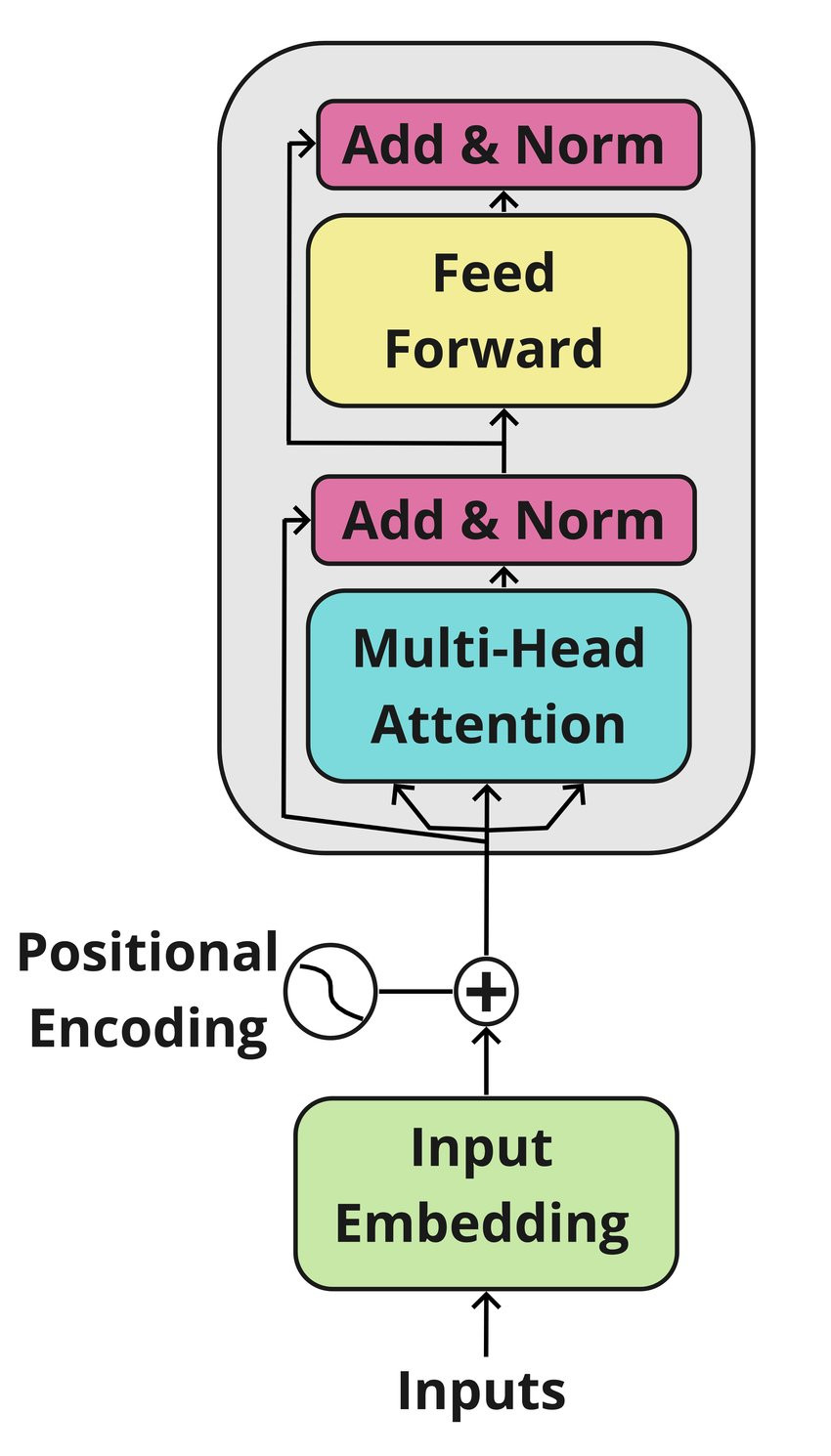
在編碼器(encoder)部分 -
程式碼提示 假設我們有32x10的輸入(批量(batch)大小=32,序列(sequence)長度=10)。一旦它通過嵌入層,它變為32x10x512。然後將其與對應的位置編碼向量相加,產生32x10x512的輸出。這將傳遞到多頭注意力
程式碼提示 多頭注意力的輸入將是32x10x512,從中生成鍵、查詢和值向量,最終產生32x10x512的輸出。
程式碼提示 多頭注意力的輸出,即32x10x512,與32x10x512的輸入(由嵌入向量創建的輸出)相加,然後該層被正規化。
程式碼提示 正規化的輸出將是32x10x512的維度。這通過2個線性層:32x10x512 -> 32x10x2048 -> 32x10x512。最後我們有一個殘差連接,它與輸出相加,並且該層被正規化。因此,創建了一個32x10x512維度的向量作為編碼器的輸出。
class TransformerBlock(nn.Module):
def __init__(self, embed_dim, expansion_factor=4, n_heads=8):
super(TransformerBlock, self).__init__()
"""
Args:
embed_dim: dimension of the embedding
expansion_factor: fator ehich determines output dimension of linear layer
n_heads: number of attention heads
"""
self.attention = MultiHeadAttention(embed_dim, n_heads)
self.norm1 = nn.LayerNorm(embed_dim)
self.norm2 = nn.LayerNorm(embed_dim)
self.feed_forward = nn.Sequential(
nn.Linear(embed_dim, expansion_factor*embed_dim),
nn.ReLU(),
nn.Linear(expansion_factor*embed_dim, embed_dim)
)
self.dropout1 = nn.Dropout(0.2)
self.dropout2 = nn.Dropout(0.2)
def forward(self,key,query,value):
"""
Args:
key: key vector
query: query vector
value: value vector
norm2_out: output of transformer block
"""
attention_out = self.attention(key,query,value) #32x10x512
attention_residual_out = attention_out + value #32x10x512
norm1_out = self.dropout1(self.norm1(attention_residual_out)) #32x10x512
feed_fwd_out = self.feed_forward(norm1_out) #32x10x512 -> #32x10x2048 -> 32x10x512
feed_fwd_residual_out = feed_fwd_out + norm1_out #32x10x512
norm2_out = self.dropout2(self.norm2(feed_fwd_residual_out)) #32x10x512
return norm2_out
class TransformerEncoder(nn.Module):
"""
Args:
seq_len : length of input sequence
embed_dim: dimension of embedding
num_layers: number of encoder layers
expansion_factor: factor which determines number of linear layers in feed forward layer
n_heads: number of heads in multihead attention
Returns:
out: output of the encoder
"""
def __init__(self, seq_len, vocab_size, embed_dim, num_layers=2, expansion_factor=4, n_heads=8):
super(TransformerEncoder, self).__init__()
self.embedding_layer = Embedding(vocab_size, embed_dim)
self.positional_encoder = PositionalEmbedding(seq_len, embed_dim)
self.layers = nn.ModuleList([TransformerBlock(embed_dim, expansion_factor, n_heads) for i in range(num_layers)])
def forward(self, x):
embed_out = self.embedding_layer(x)
out = self.positional_encoder(embed_out)
for layer in self.layers:
out = layer(out,out,out)
return out #32x10x512
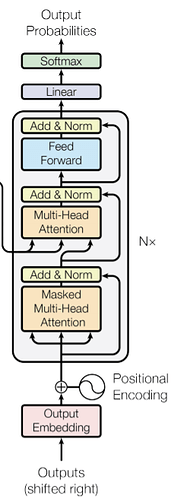
現在我們已經經歷了編碼器的大部分部分。讓我們進入解碼器的組件。我們將使用編碼器的輸出來為解碼器生成鍵和值向量。解碼器中有兩種多頭注意力。一種是解碼器注意力,另一種是編碼器解碼器注意力。別擔心,我們將一步一步進行。
讓我們以訓練階段為例來解釋。
首先,輸出通過嵌入和位置編碼來創建一個維度為1x512的嵌入向量,對應於目標序列中的每個單詞。
程式碼提示:假設我們有一個序列(sequence)長度為10。批量(batch)大小為32,嵌入向量維度為512。我們有32x10的輸入到嵌入矩陣,它產生並輸出維度為32x10x512,它與相同維度的位置編碼相加,產生一個32x10x512的輸出
嵌入輸出通過多頭注意力層,如前所述(從目標輸入創建鍵、查詢和值矩陣)並產生一個輸出向量。這次的主要區別是我們在多頭注意力中使用了一個遮罩。
為什麼需要遮罩?
遮罩的使用是因為在創建目標單詞的注意力時,我們不需要一個單詞查看未來的單詞來檢查依賴性。也就是說,我們已經知道為什麼我們創建注意力,因為我們需要知道每個單詞與其他單詞的交互的影響。由於我們正在為目標序列中的單詞創建注意力,我們不需要一個特定的單詞來查看未來的單詞。例如:在單詞"I am a student"中,我們不需要單詞"a"來查看單詞"student"。
程式碼提示:為了創建注意力,我們創建了一個由1和0組成的三角矩陣。例如:序列長度為5的三角矩陣如下:
1 0 0 0 0
1 1 0 0 0
1 1 1 0 0
1 1 1 1 0
1 1 1 1 1
在鍵與查詢相乘後,我們將所有零位置填充為負無窮大,在代碼中我們將其填充為一個非常小的數字以避免除法錯誤。 (用-1e 20)
如前所述,我們有一個添加和規範層,我們將嵌入的輸出與注意力輸出相加,然後將其規範化。
接下來我們有另一個多頭注意力,然後是一個添加和規範層。這個多頭注意力被稱為編碼器-解碼器多頭注意力。對於這個多頭注意力,我們從編碼器的輸出中創建鍵和值向量。查詢是從前一個解碼器層的輸出中創建的。
程式碼提示:因此,我們有32x10x512的編碼器輸出。從中生成所有單詞的鍵和值。同樣,查詢矩陣是從解碼器的前一層輸出(32x10x512)生成的。
因此,它通過一個多頭注意力(我們使用的頭數=8),然後通過一個添加和規範層。這裡,前一個編碼器層的輸出(即前一個添加和規範層的輸出)與編碼器-解碼器注意力的輸出相加,然後被規範化。
接下來我們有一個前饋層(線性層)與添加和規範,這與編碼器中的類似。
最後,我們創建一個線性層,長度等於目標語料庫中的單詞數量,並且與它一起有一個softmax函數來獲得每個單詞的概率。
class DecoderBlock(nn.Module):
def __init__(self, embed_dim, expansion_factor=4, n_heads=8):
super(DecoderBlock, self).__init__()
"""
Args:
embed_dim: dimension of the embedding
expansion_factor: fator ehich determines output dimension of linear layer
n_heads: number of attention heads
"""
self.attention = MultiHeadAttention(embed_dim, n_heads=8)
self.norm = nn.LayerNorm(embed_dim)
self.dropout = nn.Dropout(0.2)
self.transformer_block = TransformerBlock(embed_dim, expansion_factor, n_heads)
def forward(self, key, query, x,mask):
"""
Args:
key: key vector
query: query vector
value: value vector
mask: mask to be given for multi head attention
Returns:
out: output of transformer block
"""
#we need to pass mask mask only to fst attention
attention = self.attention(x,x,x,mask=mask) #32x10x512
value = self.dropout(self.norm(attention + x))
out = self.transformer_block(key, query, value)
return out
class TransformerDecoder(nn.Module):
def __init__(self, target_vocab_size, embed_dim, seq_len, num_layers=2, expansion_factor=4, n_heads=8):
super(TransformerDecoder, self).__init__()
"""
Args:
target_vocab_size: vocabulary size of taget
embed_dim: dimension of embedding
seq_len : length of input sequence
num_layers: number of encoder layers
expansion_factor: factor which determines number of linear layers in feed forward layer
n_heads: number of heads in multihead attention
"""
self.word_embedding = nn.Embedding(target_vocab_size, embed_dim)
self.position_embedding = PositionalEmbedding(seq_len, embed_dim)
self.layers = nn.ModuleList(
[
DecoderBlock(embed_dim, expansion_factor=4, n_heads=8)
for _ in range(num_layers)
]
)
self.fc_out = nn.Linear(embed_dim, target_vocab_size)
self.dropout = nn.Dropout(0.2)
def forward(self, x, enc_out, mask):
"""
Args:
x: input vector from target
enc_out : output from encoder layer
trg_mask: mask for decoder self attention
Returns:
out: output vector
"""
x = self.word_embedding(x) #32x10x512
x = self.position_embedding(x) #32x10x512
x = self.dropout(x)
for layer in self.layers:
x = layer(enc_out, x, enc_out, mask)
out = F.softmax(self.fc_out(x))
return out
最後,我們將設定好所有子模組並能創建整個 Transformer 架構。
class Transformer(nn.Module):
def __init__(self, embed_dim, src_vocab_size, target_vocab_size, seq_length,num_layers=2, expansion_factor=4, n_heads=8):
super(Transformer, self).__init__()
"""
Args:
embed_dim: dimension of embedding
src_vocab_size: vocabulary size of source
target_vocab_size: vocabulary size of target
seq_length : length of input sequence
num_layers: number of encoder layers
expansion_factor: factor which determines number of linear layers in feed forward layer
n_heads: number of heads in multihead attention
"""
self.target_vocab_size = target_vocab_size
self.encoder = TransformerEncoder(seq_length, src_vocab_size, embed_dim, num_layers=num_layers, expansion_factor=expansion_factor, n_heads=n_heads)
self.decoder = TransformerDecoder(target_vocab_size, embed_dim, seq_length, num_layers=num_layers, expansion_factor=expansion_factor, n_heads=n_heads)
def make_trg_mask(self, trg):
"""
Args:
trg: target sequence
Returns:
trg_mask: target mask
"""
batch_size, trg_len = trg.shape
# returns the lower triangular part of matrix filled with ones
trg_mask = torch.tril(torch.ones((trg_len, trg_len))).expand(
batch_size, 1, trg_len, trg_len
)
return trg_mask
def decode(self,src,trg):
"""
for inference
Args:
src: input to encoder
trg: input to decoder
out:
out_labels : returns final prediction of sequence
"""
trg_mask = self.make_trg_mask(trg)
enc_out = self.encoder(src)
out_labels = []
batch_size,seq_len = src.shape[0],src.shape[1]
#outputs = torch.zeros(seq_len, batch_size, self.target_vocab_size)
out = trg
for i in range(seq_len): #10
out = self.decoder(out,enc_out,trg_mask) #bs x seq_len x vocab_dim
# taking the last token
out = out[:,-1,:]
out = out.argmax(-1)
out_labels.append(out.item())
out = torch.unsqueeze(out,axis=0)
return out_labels
def forward(self, src, trg):
"""
Args:
src: input to encoder
trg: input to decoder
out:
out: final vector which returns probabilities of each target word
"""
trg_mask = self.make_trg_mask(trg)
enc_out = self.encoder(src)
outputs = self.decoder(trg, enc_out, trg_mask)
return outputs
假設我們有長度為10的輸入序列和長度為10的目標序列。
src_vocab_size = 11
target_vocab_size = 11
num_layers = 6
seq_length= 12
# let 0 be sos token and 1 be eos token
src = torch.tensor([[0, 2, 5, 6, 4, 3, 9, 5, 2, 9, 10, 1],
[0, 2, 8, 7, 3, 4, 5, 6, 7, 2, 10, 1]])
target = torch.tensor([[0, 1, 7, 4, 3, 5, 9, 2, 8, 10, 9, 1],
[0, 1, 5, 6, 2, 4, 7, 6, 2, 8, 10, 1]])
print(src.shape,target.shape)
model = Transformer(embed_dim=512, src_vocab_size=src_vocab_size,
target_vocab_size=target_vocab_size, seq_length=seq_length,
num_layers=num_layers, expansion_factor=4, n_heads=8)
model
torch.Size([2, 12]) torch.Size([2, 12])
Transformer(
(encoder): TransformerEncoder(
(embedding_layer): Embedding(
(embed): Embedding(11, 512)
)
(positional_encoder): PositionalEmbedding()
(layers): ModuleList(
(0-5): 6 x TransformerBlock(
(attention): MultiHeadAttention(
(query_matrix): Linear(in_features=64, out_features=64, bias=False)
(key_matrix): Linear(in_features=64, out_features=64, bias=False)
(value_matrix): Linear(in_features=64, out_features=64, bias=False)
(out): Linear(in_features=512, out_features=512, bias=True)
)
(norm1): LayerNorm((512,), eps=1e-05, elementwise_affine=True)
(norm2): LayerNorm((512,), eps=1e-05, elementwise_affine=True)
(feed_forward): Sequential(
(0): Linear(in_features=512, out_features=2048, bias=True)
(1): ReLU()
(2): Linear(in_features=2048, out_features=512, bias=True)
)
(dropout1): Dropout(p=0.2, inplace=False)
(dropout2): Dropout(p=0.2, inplace=False)
)
)
)
(decoder): TransformerDecoder(
(word_embedding): Embedding(11, 512)
(position_embedding): PositionalEmbedding()
(layers): ModuleList(
(0-5): 6 x DecoderBlock(
(attention): MultiHeadAttention(
(query_matrix): Linear(in_features=64, out_features=64, bias=False)
(key_matrix): Linear(in_features=64, out_features=64, bias=False)
(value_matrix): Linear(in_features=64, out_features=64, bias=False)
(out): Linear(in_features=512, out_features=512, bias=True)
)
(norm): LayerNorm((512,), eps=1e-05, elementwise_affine=True)
(dropout): Dropout(p=0.2, inplace=False)
(transformer_block): TransformerBlock(
(attention): MultiHeadAttention(
(query_matrix): Linear(in_features=64, out_features=64, bias=False)
(key_matrix): Linear(in_features=64, out_features=64, bias=False)
(value_matrix): Linear(in_features=64, out_features=64, bias=False)
(out): Linear(in_features=512, out_features=512, bias=True)
)
(norm1): LayerNorm((512,), eps=1e-05, elementwise_affine=True)
(norm2): LayerNorm((512,), eps=1e-05, elementwise_affine=True)
(feed_forward): Sequential(
(0): Linear(in_features=512, out_features=2048, bias=True)
(1): ReLU()
(2): Linear(in_features=2048, out_features=512, bias=True)
)
(dropout1): Dropout(p=0.2, inplace=False)
(dropout2): Dropout(p=0.2, inplace=False)
)
)
)
(fc_out): Linear(in_features=512, out_features=11, bias=True)
(dropout): Dropout(p=0.2, inplace=False)
)
)
